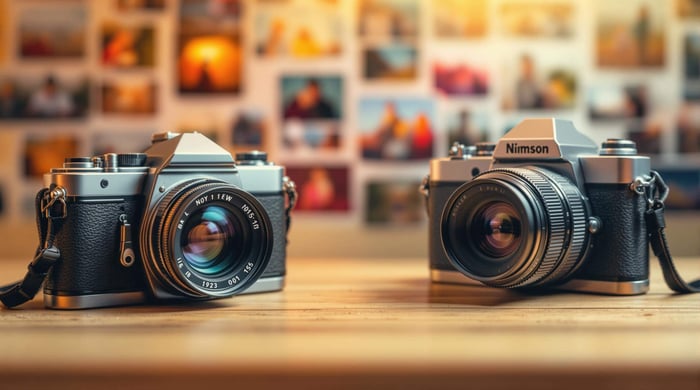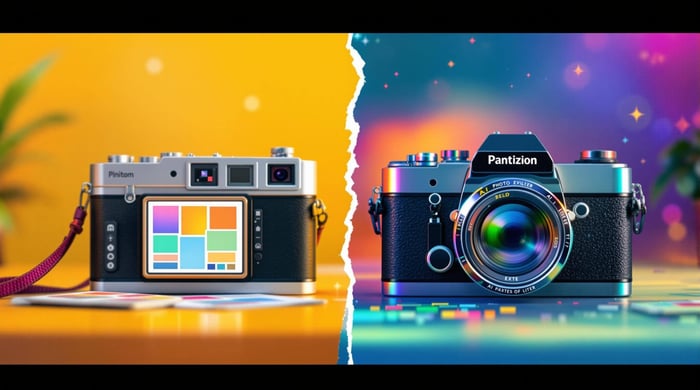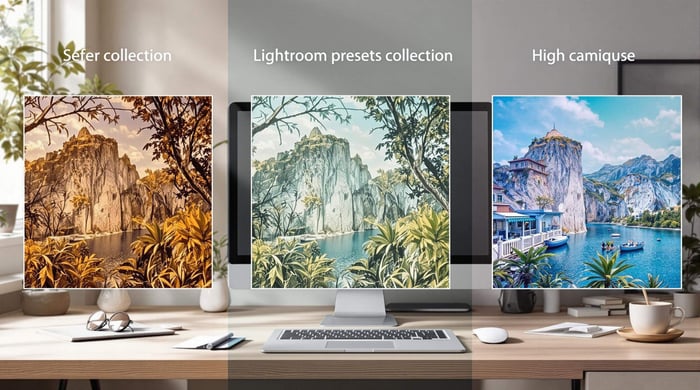Photography has an incredible history, filled with milestones that have shaped it into the art and science we know today. Here’s a quick look at 10 surprising facts that highlight its evolution:
- The first digital camera (1975) weighed 8 pounds and had a resolution of just 0.01 megapixels.
- Camera obscura, an ancient optical device, laid the foundation for modern photography.
- The most expensive photograph ever sold, Man Ray’s "Le Violon d'Ingres", fetched $12.4 million in 2022.
- Lightroom presets can cut photo editing time by up to 75%.
- Unique styles like macro, astrophotography, and drone photography offer endless creative possibilities.
- The first underwater color photo was taken in 1926, featuring a hogfish.
- 12 Hasselblad cameras were left behind on the Moon during Apollo missions.
- Digital editing tools like Photoshop borrow heavily from darkroom techniques.
- Japan’s first camera, the Cherry Hand Camera (1900), marked the start of its global camera industry.
- In 2020, over 1.4 trillion photos were taken worldwide, driven by smartphone use.
Photo taking’s journey from bulky equipment to pocket-sized devices is a testament to human ingenuity. These facts showcase how it has impacted art, science, and even space exploration.
The Evolution of the Camera: From Camera Obscura to Modern Day Digital SLRs
1. The First Digital Camera Was Heavy and Bulky
In December 1975, Steven Sasson, an engineer at Eastman Kodak, created the world’s first digital camera - a major leap in photo taking. This invention marked the shift from film to digital, laying the groundwork for the technology we rely on today. Unlike the compact devices we’re used to, this prototype weighed a hefty 8 pounds.
Built with a combination of existing parts, like a movie camera lens and early electronic components, the camera was far from user-friendly. Taking a single photo was a slow process. It used a CCD sensor to capture images, which were then stored on a cassette tape after a lengthy analog-to-digital conversion.
Its resolution? Just 0.01 megapixels - a far cry from the 12-megapixel cameras in modern smartphones, which are over 1,000 times more advanced. The first-ever digital photo, featuring Kodak lab technician Joy Marshall, marked a turning point in photography. Today, this historic prototype is displayed at the George Eastman Museum in Rochester, New York, a testament to its role in shaping the future of photo taking.
Though primitive by today’s standards, this invention was the starting point for the digital transformation of photography.
2. Camera Obscura: Photography's Ancient Beginning
The roots of photo taking can be traced back to the camera obscura, which means "dark chamber" in Latin. This device, first mentioned by ancient Chinese philosophers, revealed early insights into optical principles and laid the groundwork for modern photography.
The concept was simple yet powerful: when light passed through a tiny hole into a darkened space, it projected an upside-down image of the outside scene onto a surface inside. This natural effect demonstrated how light could be controlled to produce images, a principle that remains central to every camera today.
Over the centuries, the camera obscura served various practical and artistic purposes. Scholars used it to safely observe solar eclipses, while Renaissance artists relied on it to create accurate perspectives in their work. The basic idea of directing light through an aperture to produce an image is still the foundation of modern camera technology.
Even with today’s advanced digital cameras, the camera obscura holds educational value. Photography students often study it to better understand the mechanics of light and image creation. Its simplicity offers a clear view into the principles that continue to shape photographic techniques.
This ancient invention wasn’t just a stepping stone - it was the starting point for the evolution of photo taking, influencing everything from early film cameras to today’s digital innovations. By appreciating its origins, photographers can deepen their understanding of the craft and its enduring principles.
3. The World's Most Expensive Photograph
In May 2022, Man Ray's famous photograph "Le Violon d'Ingres" sold for $12.4 million at Christie's, making it the most expensive photograph ever sold [5]. Taken in 1924, the image features a model's bare back altered to resemble a violin, complete with f-holes, showcasing Man Ray's surrealist creativity and technical skill.
Several factors contributed to its immense value:
- Historical Importance: It captures a key moment in the evolution of surrealist photography.
- Man Ray's Influence: A major figure in the Dada and Surrealist movements.
- Technical Mastery: Highlights advanced darkroom techniques for its time.
- Scarcity: An original print from the 1920s, with very few in existence.
"Le Violon d'Ingres" is more than just a record-breaking sale - it represents a turning point in art history, blending photography with surrealist ideas. Its impact goes beyond the price tag, emphasizing photo taking's growing status as a respected art form alongside painting and sculpture.
This landmark sale illustrates how creativity and vision can increase photography's importance in both cultural and financial terms. It also reflects the medium's ability to push boundaries and influence visual storytelling - a theme found throughout photo taking's evolution.
4. How Lightroom Presets Save Time in Editing
Much like how darkroom techniques changed film photography, Lightroom presets have streamlined digital editing, making it faster and more consistent. These tools can cut editing time by as much as 75%, which is a game-changer when working with large collections, like the 800-1000 photos often captured during weddings.
Presets simplify tasks like color correction, applying styles, and batch editing, reducing the time spent on each photo from minutes to just seconds. For beginners, they’re a great way to understand how different adjustments affect an image. For seasoned photographers, custom presets can reflect their personal style, ensuring a cohesive look across their work.
Today’s presets are designed to handle a variety of lighting situations and photography styles with ease. The trick to using them effectively is to treat them as a starting point, making additional tweaks to suit each photo’s unique needs. This method balances speed with precision, helping you achieve professional-quality results without spending hours on edits.
5. Different Styles of Photography You Can Try
Photography opens the door to countless creative approaches. For instance, crystal ball photo taking uses a spherical lens to craft surreal and distorted perspectives, while Intentional Camera Movement (ICM) involves moving the camera during exposure to create abstract, dynamic effects [1]. Vertorama, a technique that stitches vertical images together, is perfect for capturing the grandeur of tall spaces or intricate architectural interiors [3].
There are many specialized techniques to explore. Macro photography dives into the tiny details of the world using special lenses. Levitation photo graphy gives the illusion of floating objects or people through clever composition and editing. Astrophotography, on the other hand, focuses on the vastness of the night sky, capturing stars and celestial wonders with long exposures. Drone photography has transformed the way we see landscapes, offering dramatic aerial views that were once out of reach [2].
For those looking to merge art with business, stock photography provides a way to blend creative expression with market trends [2]. Each style comes with its own set of challenges and rewards, whether it's the precision required for macro shots or the imaginative setups needed for levitation photography [1]. Trying out these techniques not only sharpens your skills but also encourages you to see the world in new ways, stepping outside traditional photo.graphy norms.
And the possibilities don’t stop there - photo taking extends to fascinating realms like underwater adventures, which we'll dive into next.
6. The First Underwater Color Photo Was Taken in 1926
Underwater color photography has been around for nearly a century, starting at a time when even basic photo.graphy posed serious challenges. In 1926, Dr. William Longley and National Geographic photographer Charles Martin made history by capturing the first underwater color photograph near the Florida Keys. The subject? A vividly colored hogfish.
To achieve this, they had to tackle significant obstacles like underwater lighting. Using specialized camera housing and 5x7 inch glass plate negatives, they managed to document the underwater world in color - a remarkable feat for their time. This effort transformed how marine life was recorded, moving from black-and-white images or artistic renderings to vibrant, true-to-life photographs.
Their work paved the way for the underwater photography we know today. Modern advancements like digital cameras, waterproof housings, and advanced lighting systems have taken this field to new heights, playing a key role in marine research, conservation, and underwater art.
This achievement remains a testament to human creativity and continues to inspire photographers to push boundaries, much like the groundbreaking work done in space photo taking.
7. Cameras Left Behind on the Moon
There are still twelve Hasselblad cameras sitting on the Moon, left behind as part of the Apollo missions. These cameras captured some of the most unforgettable images in history.
Each Hasselblad was specially modified to handle the Moon's harsh conditions. Weighing 3.5 pounds and measuring 6x4 inches, they were designed to work with bulky space gloves. They also featured adjustments to endure extreme temperatures and radiation on the lunar surface.
Why were they left behind? It came down to a practical choice. Every pound of equipment left on the Moon allowed astronauts to bring back an extra pound of lunar samples. Once the cameras had served their purpose, they were considered less important than the priceless rock and soil samples.
These cameras documented moments like Neil Armstrong’s first steps, and now they remain on the Moon as historical artifacts, protected by international agreements.
Their story underscores how photo taking has played a key role in capturing the milestones of space exploration. The lessons learned from these cameras have even shaped modern designs for equipment used in extreme environments. It’s a reminder of how necessity drives innovation, both in space and beyond.
8. How Darkroom Techniques Influenced Digital Tools
Today's digital editing tools, like Photoshop and Lightroom, owe much to traditional darkroom practices. These tools have taken the creative methods of analog photography and made them more precise and accessible for modern photographers.
For instance, Photoshop's dodge and burn tools are digital versions of classic darkroom techniques used to lighten or darken parts of an image. The idea of layers in digital editing comes from stacking negatives or masks in the darkroom, now allowing photographers to edit specific parts of an image independently without altering the original. Similarly, the Curves tool offers advanced tonal adjustments that build on the darkroom's contrast control methods - but with far more precision.
Here’s a comparison of how darkroom techniques have evolved into digital tools:
| Analog Technique | Digital Tool | Modern Advantages |
|---|---|---|
| Chemical developers | Contrast sliders | Accurate, numerical adjustments |
| Multiple negatives | Layer system | Unlimited layers with blend options |
| Masking sheets | Layer masks | Non-destructive and flexible masking |
| Chemical toning | Split toning tools | Independent control over tones |
Even Ansel Adams' Zone System, a method for controlling black-and-white contrast, has been adapted to digital workflows. It retains its core principles while benefiting from the efficiency and flexibility of modern software.
9. The First Japanese Camera Was a Joint Effort
Japan's journey into camera manufacturing started earlier than many might think. In 1900, Konishi Honten, the company that would eventually become Konica Minolta, introduced the "Cherry Hand Camera" - a pivotal moment in Japan's photographic history.
The Cherry Hand Camera stood out with its folding design, making it easy to carry and use. Interestingly, Konishi Honten began as a pharmacy before branching out into camera production, signaling a bold shift in focus. This move set the stage for the rise of major players like Canon and Nikon, positioning Japan as a powerhouse in the camera industry.
The Cherry Hand Camera played a key role in making photo taking more accessible. Its design reflected a shift from niche, specialized equipment to practical tools for everyday use. This early effort not only shaped Japan's camera industry but also contributed to advancements in photo taking worldwide.
This milestone underscores the role of early creativity and ambition in shaping the global landscape of photography, a medium that continues to thrive and evolve to this day.
10. Surprising Numbers About Photography Today
Photography has come a long way - from cumbersome equipment to the convenience of smartphones - and its influence on our lives has skyrocketed. In 2020 alone, over 1.4 trillion photos were taken worldwide [1]. This boom was largely driven by smartphones, with over 1 billion camera-equipped smartphones sold that year.
Social media has become the go-to platform for sharing photos. Together, Instagram and Facebook see nearly 400 million photo uploads every day [4]. This massive volume underscores how photo taking has become a key part of how we communicate and share our experiences online.
The business side of photo.graphy is thriving too. By 2025, the global photography market is expected to hit $44.9 billion [3]. This includes everything from professional-grade gear to services for everyday consumers, showing how photo taking is more accessible and commercially relevant than ever.
Photography's artistic value has also soared. Andreas Gursky’s "Rhine II" once held the record for the most expensive photograph sold, until it was surpassed by Man Ray's "Le Violon d'Ingres." These sales highlight photography's evolution from a tool for documentation to a respected and high-value art form.
These figures show how photography has become a universal tool for storytelling. With billions of people carrying powerful cameras in their pockets, we’re capturing and sharing life’s moments like never before. This shift has reshaped how we see and document the world, paving the way for even more changes ahead.
Conclusion
The journey of photography showcases not just advancements in technology but also the endless imagination that fuels this art form. These milestones remind us how photography continues to shape how we see and interact with the world.
From the clunky cameras of the past to today’s advanced tools, photography has transformed dramatically, empowering professionals and hobbyists alike. It influences how we document history, express ourselves, and connect with others, offering countless ways to experiment and grow.
By exploring photography's rich history and leveraging modern tools, we can push this art form even further. Technologies like AI editing and 360-degree imaging are already changing the game, proving how curiosity and innovation can redefine what’s possible. These advancements encourage us to see the world - and photo taking itself - in new ways.
For those diving into photo taking, understanding its history and embracing modern techniques can spark fresh ideas. Whether you’re drawn to wildlife, portraits, or photojournalism, experimenting with different styles can help you discover your own perspective [2]. Photography is a journey without limits, where every new approach or insight adds depth to the craft.
Each photo you take becomes part of the ongoing story of this ever-evolving art form.



.png)




